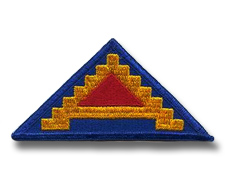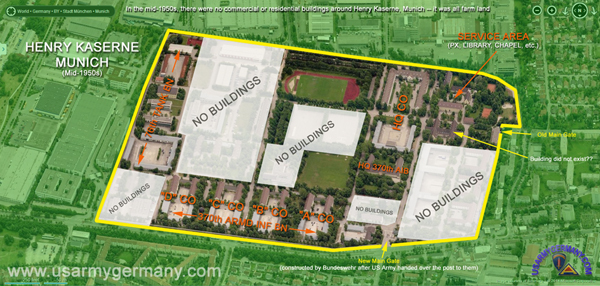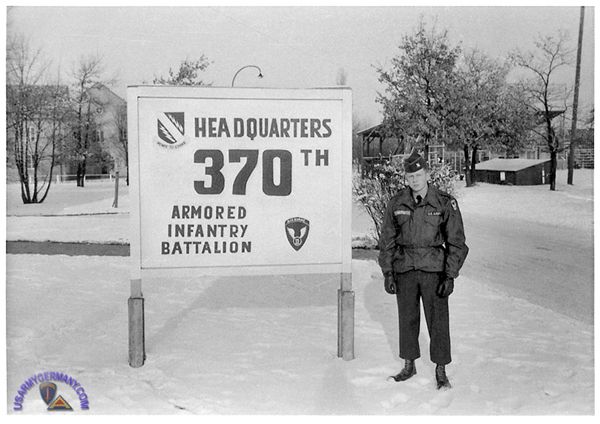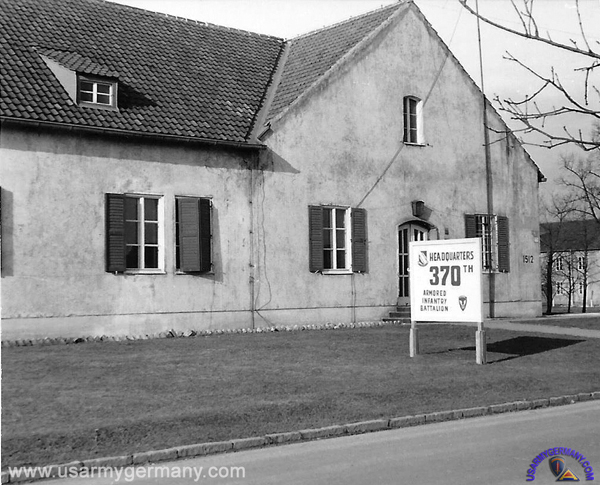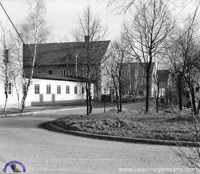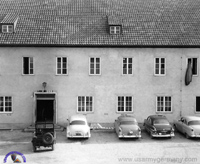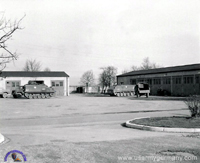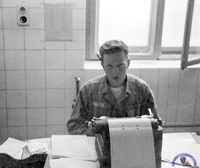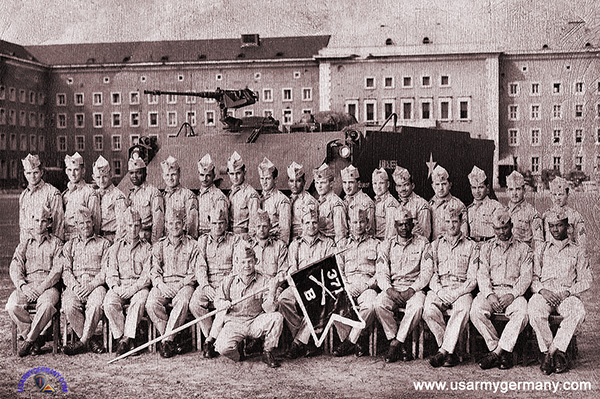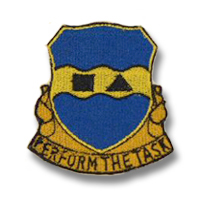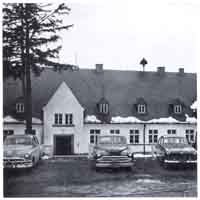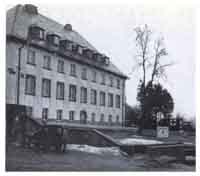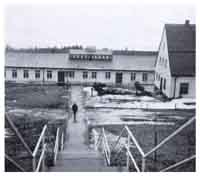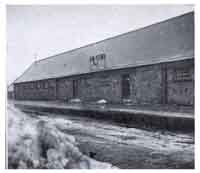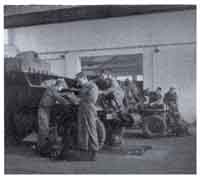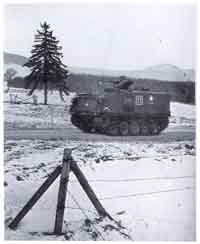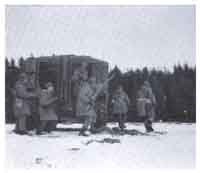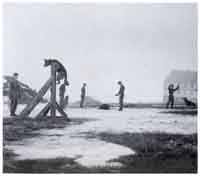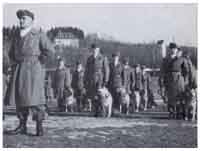| If you do
NOT see the Table of Contents frame to the left of this page, then
Click here to open 'USArmyGermany' frameset |
|||||||||||||
Armored Infantry / Armored Rifle Battalions (Separate) |
|||||||||||||
|
|
|||||||||||||
|
|||||||||||||
|
|
|||||||||||||
| 370th Armored Infantry Battalion / 1st ARB, 46th Inf | |||||||||||||
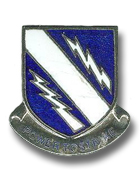 370th Armored Infantry Battalion DUI 370th Armored Infantry Battalion DUI |
|||||||||||||
| 1949 | |||||||||||||
| (Source: STARS & STRIPES, March 23 1949) | |||||||||||||
| In a ceremony before approximately 2,600 troops, Col Harry J. Wheaton, commanding officer of the 6th Armd Cav, U.S. Constab, presented the distinctive Constabulary patch and yellow scarf to six representatives from the 370th Infantry Battalion, marking the acceptance of that unit into the U.S. Constabulary. One officer and one enlisted man from each of the companies of the infantry battalion accepted a patch and scarf on behalf of their units. Wheaton welcomed the battalion into the Constabulary in a short address to the troops and Maj Walter H. Dabney, of Washington, commanding officer of the 370th Inf Bn, read a letter received by the battalion from Maj Gen I. D White, Constabulary commander, in which he extended a welcome to members of the battalion as new members of the Constabulary. (Webmaster note: the 370th Inf Bn is attached to the 6th Armd Cav (US Constabulary).) |
|||||||||||||
| 1956 | |||||||||||||
| (Source: Email from Robert White) | |||||||||||||
| I was a voluntary draftee who served in the 370th Armored Infantry Battalion at Henry Kaserne, about seven kilometers outside of Munich. My overseas term was from Sep. 1956 to Aug. 1957. I served as a personnel clerk for Charlie Company and my work assignment was with battalion HQ. There were four of us personnel clerks, one each from A, B, C, and D companies; also, there was a personnel clerk from HQ Company and a personnel clerk who was assigned to all of the battalion’s officers’ records. Mr. Eyester was the Warrant Officer in charge of our personnel section as assisted by Sgt. Mutell. I am amazed at the (German) development around the base. I recall it being mostly open field areas in which German farmers planted potatoes and other vegetables. In fact, just slightly southeast of the base the 11th Airborne Division paratroopers would be exiting USAF C-119s monthly and dropping down on open land. We could easily see them floating down but were not close enough to view them landing. Also about a quarter of a mile east and slightly south of Henry Kaserne there was a left over massive cement structure which the German Wehrmacht used for rifle and machine gun practice in the late 1930s and early ‘40s. It resembled a huge handball court that was three to four stories high. Now I see that this structure is no longer standing and has been replaced by many buildings and homes that had formerly (1956-57) been open farmland, fields and pastures. I completed Basic Infantry training and Advanced Infantry Training at Fort Ord in CA. Next, I received assignment to Charlie Company, 16th Infantry Regt., First Division at Ft. Riley, Kansas. The Big Red One had just recently transitioned from Germany back to the USA when we new trainees from CA were assigned to the division. I was stationed there for six months and just barely had enough remaining time left to be transferred overseas to West Germany. I still retain my “Power to Strike” battalion uniform symbols. |
|||||||||||||
ADDITIONAL INFORMATION Personnel: these are some of the names that I recall from my time at Henry Kaserne: First Sergeant of C Co. was named Willowby but I don't recall his first name. Bruce Hicks and Jack Kreager were both voluntary draftees from Southern California. Kreager's home was in Compton, a suburb of Los Angeles. Both had established records for injuries to a leg and therefore had light-duty assignments. This really annoyed Capt. Strobridge so they would limp excessively when he was around. Kreager and I flew from Landstuhl, a USAF airbase in Bavaria, to Paris. then on to London before returning to Munich. We had the most amazing experience at Landstuhl, when a C-54 was taxiing on the runway for take-off. The tower reported our presence and interest in a ride to Paris; so the pilot stopped his plane, cut the engines and waited while a jeep took the two of us to the airplane to board. We were not yet even into our seats before we were airborne. We could not appreciate enough what the Air Force did to get us on that flight. The Amy would not have been so charitable to two low-ranking draftees. Interestingly, Kreager did not limp while with me in Paris and London! Joseph Smith was from Virginia: he was the battalion mail clerk. Arnold Sell maintained the battalion officers' service records; he was assigned to HQ Co. He was a draftee from Southern California like me. Unlike me, he bought a new 1957 Karmann-Ghia in Frankfurt. Dale Molitor was the B Co. personnel clerk and a draftee. When his father arrived tom the US (they lived in Iowa) he and Dale visited living relatives in Luxembourg. Blas Blas was a Guamaian from Guam and an RA. I don't recall his duties. His given name and sumame were the same. (___) Erickson was the A Co. personnel clerk and a draftee. Spec. 4 (___) Bravo ranked above us line company personnel clerks; I don't recall his duties. They might have related to financial records. One week each year we stayed at Army Finance HQ and reviewed our five companys' finance records against our personnel records. I don't think we did this in Munich, but it was somewhere in Bavaria. It was nice to get away from Henry Kaseme without having to go set up in a big tent in the countryside with our typewriters and folding tables while the line troops ran around in the fields. Mt. Eyester told us that if war started (USSR) we could fall back and set up in a school or hotel or someplace similar. Apparently, he did that in WWII. Vincent Baldissari was of Italian parentage from the US. He was RA and visited some of his relatives in Rome. He owned a car and drove down into Italy. I don't recall his assignment. I am sure he was in HQ Co. (___) Scalsetti had a loudmouth NYC type of personality. (I know the type -- I'm from Buffalo.) He was always joking around. I think he was RA. He teased Mr. Eyester and Sgt Mutell, and got away with it. His conduct seemed incredulous to me but he got away with it. I think he was in HQ Co. (___) O'Conner was the D Co. personnel clerk. He was a draftee. Master Sergeant Soccor was the battalion re-enlistment NCO; he, too, reported to Mr. Eyester. He, too, was one of those WWII soldiers who preferred to stay on in West Germany. As my release time started to come around, Capt. Strobridge made various inducements and offers if I would enlist and become RA. He suggested that if I enlisted for a three-year term that I could get assigned to the Adjutant General Corps. I put him off by saying that I was thinking about it. While I was on leave in Paris and London, Jack Kreager told me how he and Hicks were filing early release applications for going to college before the fall 1957 semester began. I had not been aware of this option until hearing about it from both Hicks and Kreager. Upon returning from my leave to England and France in mid-July, I submitted my early release for college registration. When Capt. Strobridge saw it, he remarked, "Well, I guess, White, that you have made up your mind?" "Yes, sir" was all I said to him. (I didn't inform Capt. Strobridge that the corporal who was the battalion clerk who typed up all of the court martial documents was himself court martialed for being Absent Without Leave. That too, was a clincher for me.) |
|||||||||||||
|
|||||||||||||
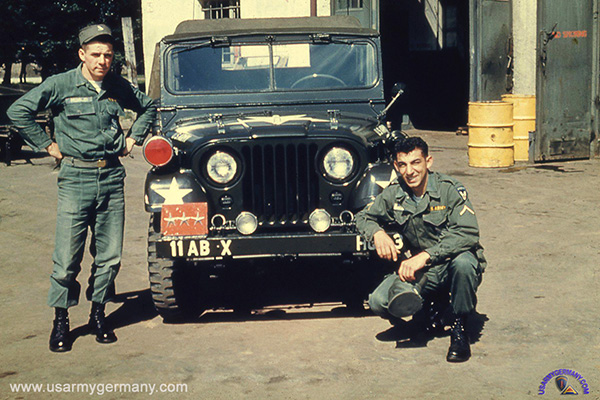 370th AIB - 11th Abn Div CG jeep (John Figaro) |
|||||||||||||
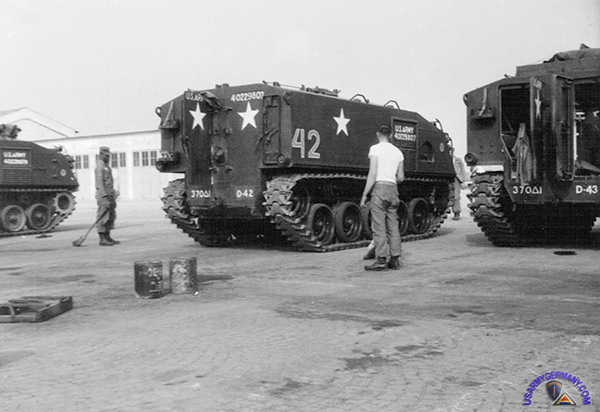 370th AIB - cleaning our tracks in the "D" Company motor pool (John Figaro) |
|||||||||||||
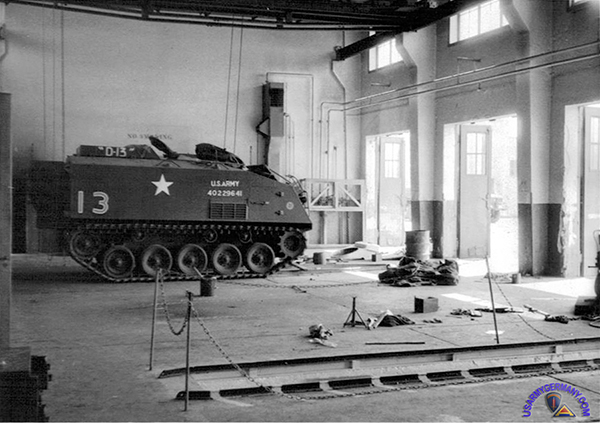 370th AIB - inside the "D" Company maintenance shop (John Figaro) |
|||||||||||||
| (Source: Email from John R. Figaro) | |||||||||||||
| I was with the 370th Armored Infantry Battalion, APO 29, from 1956 to 1958. We were at Henry Kaserne, Munich 1958. | |||||||||||||
| (Source: STARS & STRIPES, Oct 30, 1957) | |||||||||||||
| The 370th Armd Inf Bn is part of the 11th Abn Div. | |||||||||||||
|
|
|||||||||||||
| 371st Armored Infantry Battalion / 1st ARB, 48th Inf | |||||||||||||
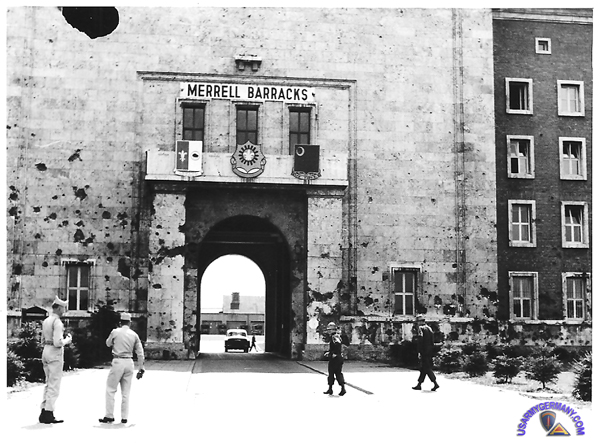 371st AIB at Merrell Barracks (SS-Kaserne), mid-1950s (LeRoy Anderson) |
|||||||||||||
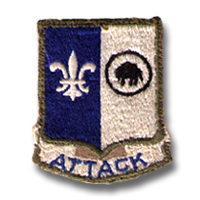 371st Armd Inf Bn Pocket Patch 371st Armd Inf Bn Pocket Patch |
|||||||||||||
| 1954 | |||||||||||||
| (Source: Email from James A. Johnson) | |||||||||||||
| I was stationed at Merrill Barracks in Nurnberg from April 1954 to August 1955. I was company clerk in Company C of the 371st Armored Infantry Batallion. We traveled in personnel carriers which were on tracks like tanks. They had their cost stenciled on the body. I think it was $99,999. We would go on early morning battle alert, scurry to the woods where a breakfast chow line would be set up. I had an emergency supply housed in a trunk. The daily morning report had to go out no matter what. We were attached to the 2nd Armored Cavalry. The German Mark was worth only 25 cents American. No wonder the German populace didn't like us. I became staff sergeant and drew about $160.00 Where could you spend it? Merrill Barracks was like a hotel. As everyone knows, it had housed the Storm Troopers of the Germans . |
|||||||||||||
| (Source: Email from LeRoy Anderson) | |||||||||||||
| I was stationed at Merrell Barracks in Nurnberg from Jan 1954 and left in April or May of 1956. I always refered to it as the SS Kaserne. As you view the main gate from the front, my room was on the left, first floor. I could see the main entrance from my window.
I was assigned to Recon Patoon, Hq. Company, 371st Armd Inf Bn. Started out in a rifle squad, then became T-18 driver and eventually ended up in the Tank section (M41 Tanks). A very interesting assignment. It has been a long time, but here is what I remember of the organization of Headquarters and Service Company, 371st AIB (with Supply Platoon, Mortar Platoon, and Recon Platoon). |
|||||||||||||
| 1955 | |||||||||||||
| (Source: Email from Lional Isbell) | |||||||||||||
| I was with the 371st AIB from Jan 1955 thru Jun 1957. The unit had been an all black unit and when I was assigned there still were black soldiers and white officers from that era. I remember the First Sgt was a holdover from that era.
I was first assigned to Delta Company and later to Headquarters & Headquarters Company in the S4 (supply section). The unit moved from Merrell Barracks to Worms Germany in Dec 1957. I’m the one that convoyed all the basic rations, ammo, and petrol to an arriving Armored Division unit in the Stuttgart area. I remember it was thanksgiving day 1957, and the Support Platoon leader (Lt Gaydosh) left me (an SP4) in charge while he went home to his wife. At the time I filled the slot as “Assistant Battalion Supply Sgt” so was expected to be in charge. I’ve attached my picture and a picture of the unit patch. I thank you for maintaining the site. Maybe more people will make contact thru it. As a note: My first assignment after training (a Private) was with the 371st AIB (attached to the 2nd Armored Regiment) and my last overseas assignment, 17 years later, (as a Chief Warrant Officer) was with the 1st Squadron, 2d ACR at Bindlach, Germany and the Regimental Headquarters was at Merrell Barracks (1971-1974). |
|||||||||||||
| 373rd Armored Infantry Battalion / 3rd ARB, 50th Inf | |||||||||||||
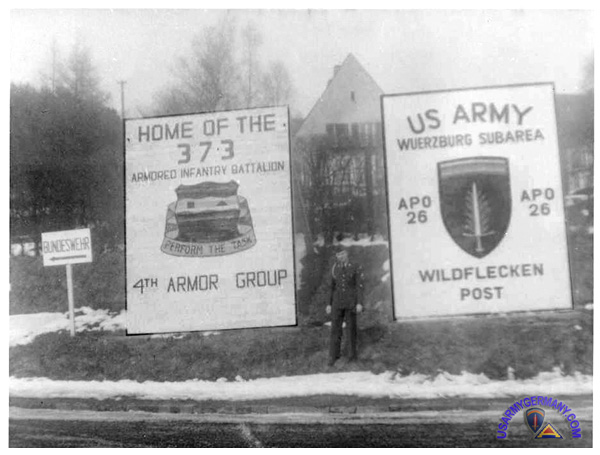 Signs near Camp Wildflecken, mid-1950s (Len Griffith) |
|||||||||||||
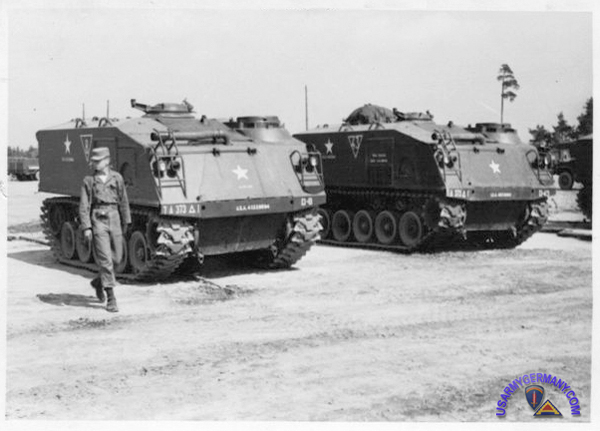 M-75 armored personnel carriers of the 373rd AIB, 1954 (Ken Bruce) |
|||||||||||||
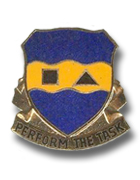 373rd Armored Infantry Battalion DI 373rd Armored Infantry Battalion DI |
|||||||||||||
| (Source: 19th Armor Group Germany 1954, Yearbook) | |||||||||||||
| 373rd Armored Infantry Battalion The 373rd Armored Infantry Battalion, activated in October 1948, is a youngster in comparison to the other battalions of the 19th Armor Group, but in maintaining a high standard of performance, it holds its own. The keynote of all progress made and successes gained in every phase of activity has been the spirit of "performing the task at hand." It was only appropriate that after a year of working together as a unit, the Battalion chose as its motto, "Perform the Task." The objectives in training throughout the 373rd's existence have been to increase the level of achievement in individual military training; to develop the tactical proficiency of all echelons; to heighten the professional acumen of all officers and non-commissioned officers; to train specialists and insure their proper replacement through the battalion; and, to instill in every soldier the elements of high physical endurance, discipline, esprit and individual pride through progressive, well-planned training. |
|||||||||||||
|
|||||||||||||
| Significant
at the command level was the assumption of command of the 373rd by
Lt. Col. Herbert A. Barrow, relieving Major James R. Hillard, on 3
February 1950. The status, unit location and post assignment of 1949
continued unchanged throughout 1950. Several moves took place in the Spring of 1951. The first came in April when the 373rd moved to Wackernheim. In June, a more permanent move was made to Wildflecken, the present station. The unit was relieved from attachment to the 1st Constabulary Brigade and attached to the 4th Infantry Division as of 1 July 1951. A major point in his history occurred on 19 July 1951, when the status of the battalion was changed considerably, due to reorganization. The designation was changed to 373rd Armored Infantry Battalion. In general, the transition from a ground infantry unit with limited potentialities to one with tremendous firepower and complete mobility progressed to a high degree of satisfaction in the remaining portion of that year. In August, the Battalion was relieved from attachment to the 4th Infantry Division and was attached to V Corps. Lt. Col. James D. Fowler assumed command on 15 November 1951, relieving Lt. Col. Barrow. He remained at this post until Lt. Col. William N. Culver replaced him on 25 April 1953. An immediate problem that Lt. Col. Colyer found himself faced with was an 87 percent changeover in personnel. At that time all combat-type units were to effect an integration of an approximation of 88 percent Caucasian and 12 percent Negro population. The 373rd was one of the first units in the theater to be integrated. At the conclusion of this operation the 373rd was in all respects a newly organized unit, and yet it had to maintain the operational readiness of a combat-ready unit. In 1953, the 373rd hit its stride. It received an "excellent" rating for army-training tests and the annual Inspector General's test (IG) from V Corps. In September of that year, Col. R. H. Schultz of the 4th Infantry Division, 12th Regiment, reported that the 373rd "did an outstanding job in performing its assigned mission of obtaining maximum delay" during the field training exercise "Monte Carlo." The early months of 1954 saw the Battalion continuously striving to improve itself as an efficient fighting team, with the spirit, morale and interest in training constantly improving, ready to live up to its motto of "Perform the Task." (Webmaster Note: The 373 Armd Inf Bn would remain in Wildflecken and eventually (on 1 April 1958) be inactivated and replaced by the concurrently activated 3rd Armored Rifle Battalion, 50th Infantry) |
|||||||||||||
| (Source: Email from Len Griffith) | |||||||||||||
| You have a comment next to the 373rd ARB, about it was probably the 373rd AIB, Armored Infantry Battalion. It was. I have attached photo (see above) taken at post around mid 1950's when I was there. I'm the one in between the signs. I was with the Hq & Hq Company for the Battalion. |
|||||||||||||
| (Source: Email from Thomas Short) | |||||||||||||
| I was Message Center Chief, Col Barrow made me Sgt, maybe first, or second week he was there. We were originally an Infantry Battalion and changed over to Armor. I'm the person who helped put in the radios and communications equipment. In the change over, all of the half tracks had no communications. We were blind until we got everything up and going. We only had two Tanks at first. I'm the one who retired the records (1951) to Kansas City. I'm wondering are they still available? Some of my fondest memories, I'm 75 now, were of keeping Our Bn together I got to Europe in the winter. As you probably know traveling the Atlantic in winter is not fun. Giessen, Germany was where the 373rd began as I knew it. Three companies in Giessen and one company in Darmstadt out of Wiesbaden. Being a clerk in message center I traveled quite a bit, we did not have the communications we have now. I had Airplane drops. Anything that was "secret" or of that level I hand carried. Our job was, before the (Berlin) Airlift, being the troops that went along with the trucks that kept Berlin alive. The Airlift is well known but the little stuff that went before is not publicized. We also were " show off troops". |
|||||||||||||
|
|
|||||||||||||
| 746th Armored Infantry Battalion / 2nd ARB, 46th Inf | |||||||||||||
| The 746th Armored Infantry Battalion was formed in early 1955 at Foch Kaserne (later redes. Taukkunen Bks) in Worms, Germany. The battalion was attached to the 2nd Armored Division. Sometime in 1957, the battalion was moved to Kirch-Göns and attached to the 3rd Armored Division. In 1958 the battalion was redesignated as 2nd Armored Rifle Battalion, 46th Infantry, under the CARS program. Webmaster would be interested in hearing from you if you have any additional details about this unit during the 1955-1958 time frame! |
|||||||||||||
| Related Links: |
|||||||||||||
